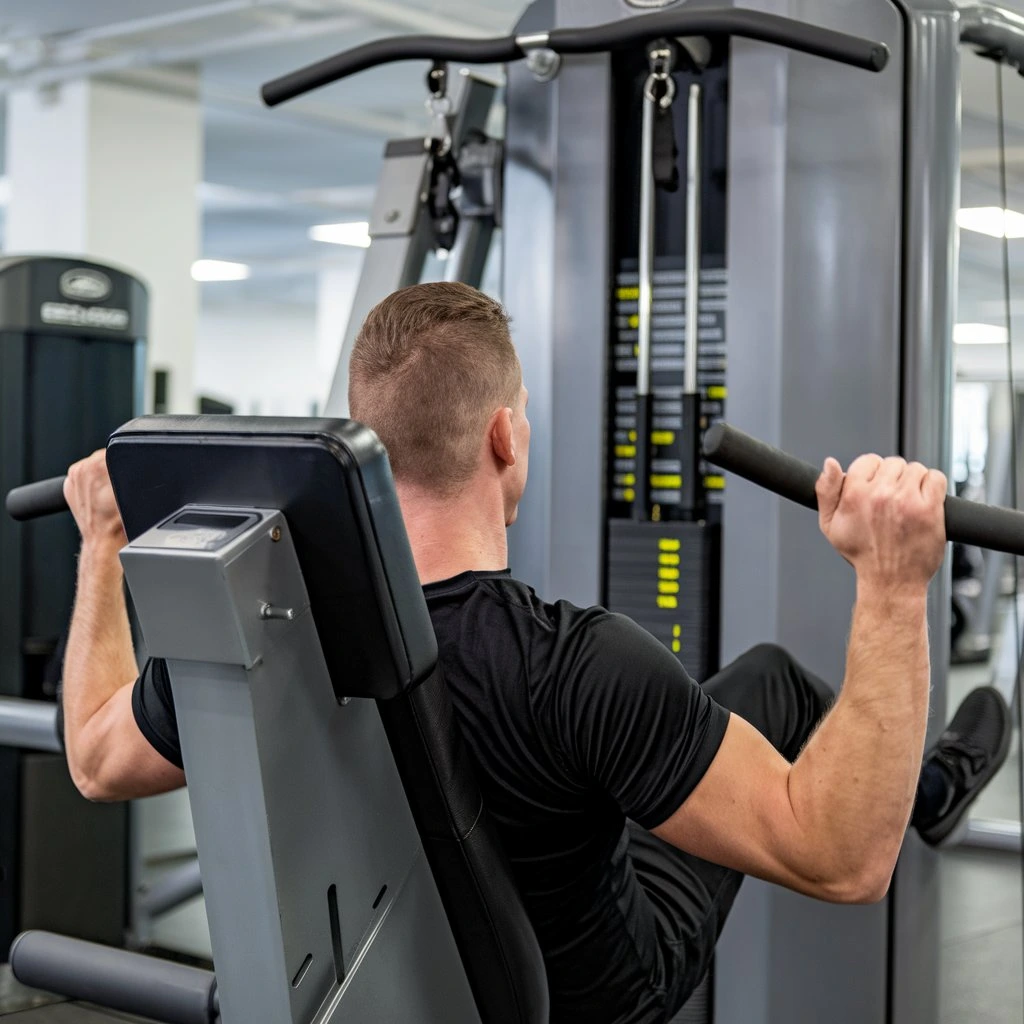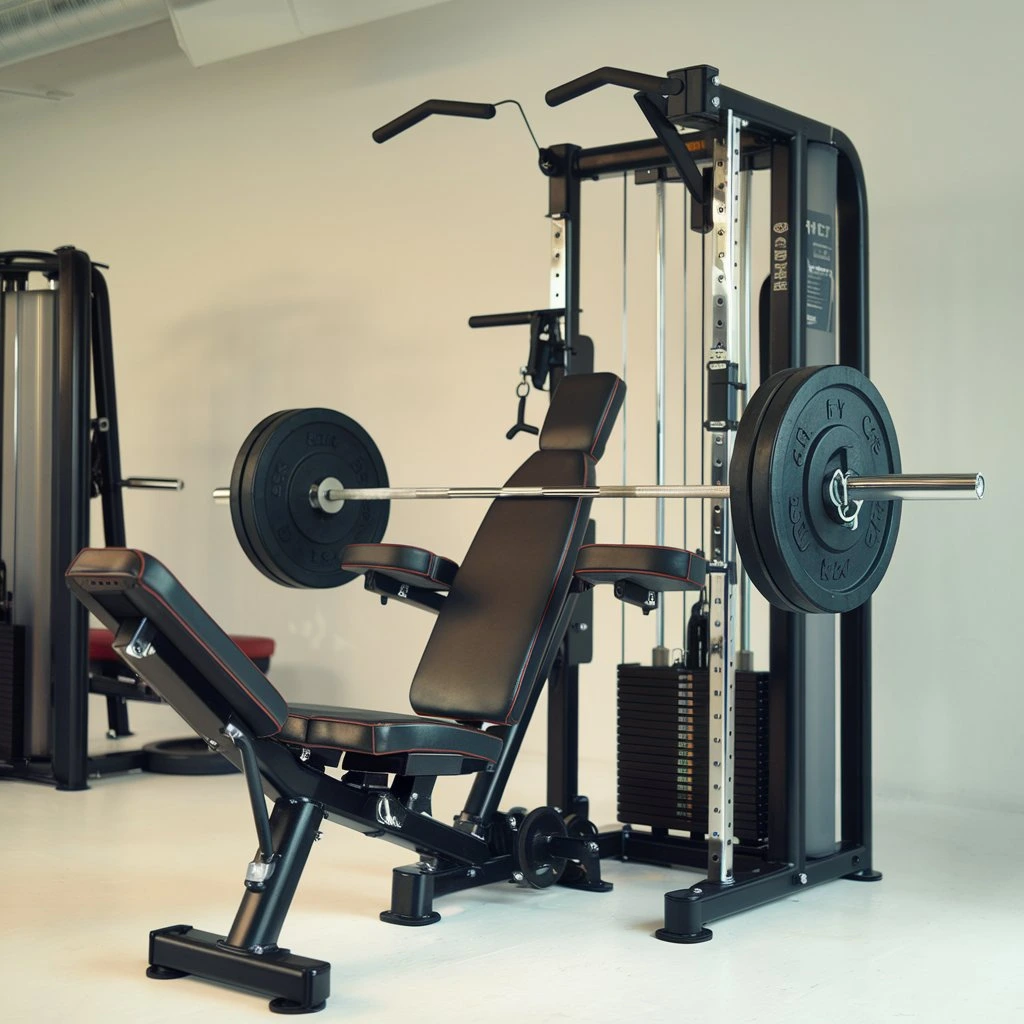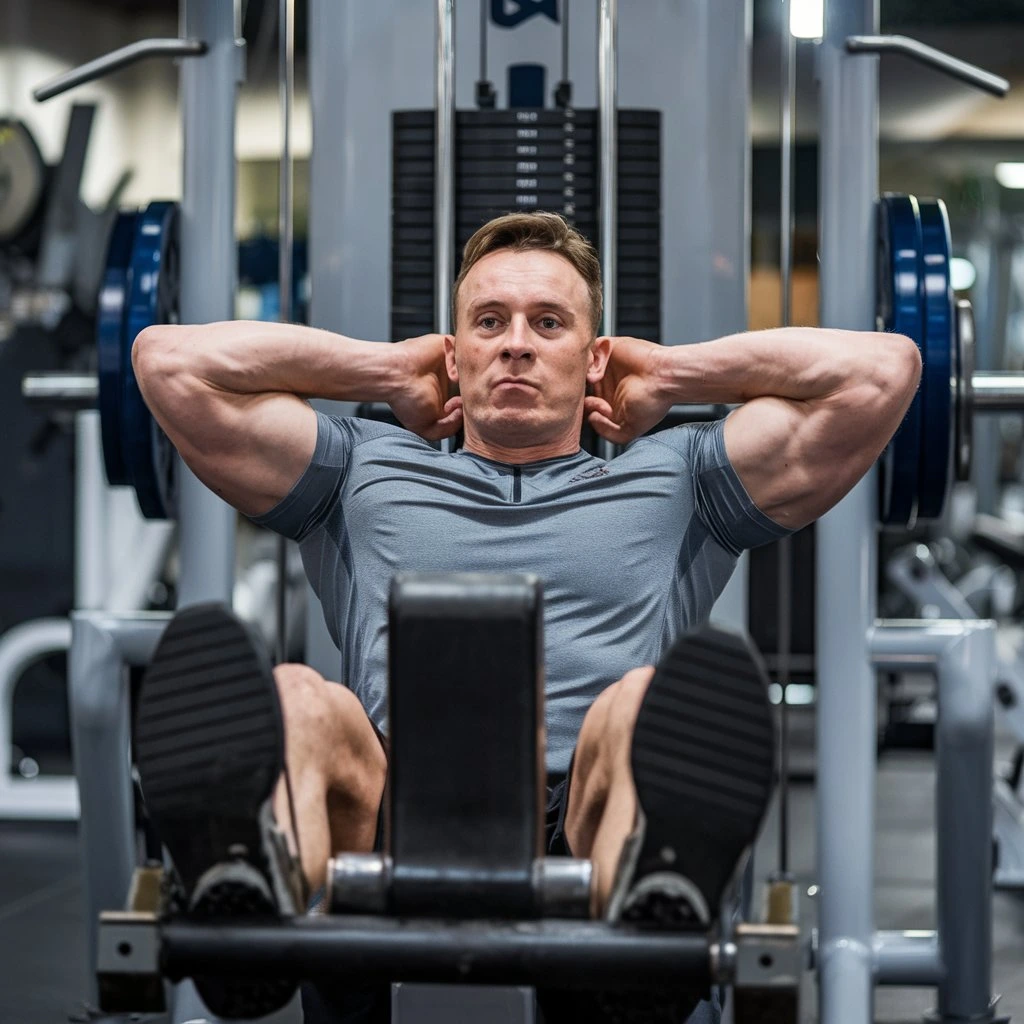The machine is for exercising. It helps people work out their leg muscles. It’s called “reverse” because of the regular leg press machine. On it, you push weights away from you. This “reverse” machine is different. With this one, you push the weights towards you. It’s like doing a leg press but in a different direction.
Definition and Purpose
The reverse leg press machine is all about giving your leg muscles a good workout. It helps you strengthen muscles like your quadriceps, hamstrings, and glutes. When you use this machine, you sit down and push against a platform with your legs. This action makes your leg muscles work hard, helping them get stronger and more toned. It’s popular with people who want to build leg strength and get fitter.
Brief History
The reverse leg press machine has been around for a while now. It was invented as a variation of the traditional leg press machine, which has been used in gyms for decades. The reverse version targets muscles differently. It offers a fresh challenge for those looking to change their workout. Over time, it has become a staple in many gyms and fitness centers. It gives people a handy way to work on their leg muscles and meet their fitness goals.
Mechanics of Operation
The machine is for fitness. It is for the legs and lower body. It is designed to target and strengthen different muscles. It has many key parts. They work together to make a safe and good workout.

- Seat: The machine features a comfortable seat where the user sits during the exercise. The seat is adjustable. It fits users of different heights and sizes. This ensures proper alignment and support during the workout.
- Backrest: A backrest is behind the seat. It gives more support and stability to the user’s back during the exercise. It helps maintain proper posture and prevents strain or injury.
- Foot Platform: The reverse leg press machine’s most distinct part is the foot platform. It’s at the front of the machine, unlike traditional leg press machines. The user places their feet on the platform and pushes against it to perform the exercise.
- Weight Stack: The machine has a weight stack. It resists the user’s movements. The weight stack is adjustable. Users can make their workout harder or easier by adding or removing weight plates.
- Pulley System: A pulley system connects the weight stack to the foot platform. It lets the user control the amount of resistance they face during the exercise. The pulleys ensure smooth and consistent movement throughout the range of motion.
- Handles: Some leg press machines may also have handles. The user can hold them for stability and control during the exercise. These handles are typically located on either side of the seat or attached to the frame of the machine.
Functionality
Reverse Motion Concept
- The reverse leg press machine flips the traditional leg press motion on its head. You push the weight away with your legs. Then, you sit facing the machine and push the platform towards you. This reversal of motion uniquely targets your muscles. It’s like doing a leg press in reverse!
Muscle Engagement
- When you push the platform towards you on the leg press machine, it targets different muscles. This is the reverse of the regular leg press. Both exercises work your leg muscles. But, the reverse leg press emphasizes your hamstrings and glutes (butt muscles) more. It also engages your calves and quadriceps (front thigh muscles) to some extent. This variety in muscle use helps build strength and balance in your lower body.
Benefits of Reverse Leg Press
Targeted Muscles
- Quadriceps: These are the big muscles in the front of your thighs. When you use the reverse leg press machine, it helps to strengthen and tone these muscles. This can make activities like walking and climbing stairs easier.
- Glutes: Your glutes are your butt muscles. Using the reverse leg press machine also works these muscles. Stronger glutes can give you a perkier, more toned rear end. They can also help with stability and posture.
- Hamstrings: These muscles are at the back of your thighs. When you push against the machine, you’re also engaging your hamstrings. Building these muscles can improve your ability to bend your knees and move your legs back. This is important for activities like running and bending down.

Joint Health and Safety
- Less Stress on Joints: The machine eases stress on your joints. It does this by reversing the leg press movement. This is compared to other leg exercises like squats or leg presses. This means less strain on your knees, hips, and lower back. It can help prevent injuries and discomfort.
- Proper Alignment: The machine is designed to guide your body through the exercise. It keeps the body in proper alignment. This helps you keep good form during the movement. It reduces the risk of straining your joints or muscles.
- Controlled Movement: The machine is for controlled movement. It lets you control the motion and resistance. You can adjust it to fit your fitness level and comfort. This controlled movement helps protect your joints by avoiding sudden or excessive stress.
- Targeted Muscle Engagement: The reverse leg press mainly targets your quadriceps. Those are the muscles on the front of your thighs. But, it also works other muscles like the glutes and hamstrings. Strengthening these muscles can give more support to your joints. It will enhance joint health and stability.
- Customizable Settings: Many leg press machines can be adjusted. You can change the seat position and weight resistance. This customization lets you find the best settings for your body. It reduces the risk of joint strain or discomfort.
Versatility in Training
The reverse leg press machine is pretty versatile when it comes to training. You can adjust it to target different muscles in your legs and glutes. For example, by moving your feet on the platform, you can focus more on your hamstrings or your quads. You may modify your workout to meet your objectives. You can build muscle or improve strength and flexibility. Plus, it’s safer for some people. It’s better for your back than traditional squats or leg presses. So, you get a good workout without putting too much strain on your body.
Variations and Modifications
Adjustable Footplate Angles
One way to vary the reverse leg press machine is by adding adjustable footplate angles. This means you can change the angle of the footplate to target different muscles in your legs. For example, setting the footplate at a higher angle can focus more on your calves. A lower angle might target your quads and hamstrings. You can adjust the footplate angle. This lets you customize your workout and work different muscle groups.
Resistance Options
You can also modify the reverse leg press machine. You can do this by adding resistance options. This could involve adding resistance bands or weight plates. They make the exercise harder. By changing the resistance, you can make the exercise harder. Do this as you progress in your fitness journey. This helps to continuously challenge your muscles and promote strength and muscle growth.
Incorporating Accessories
You can also enhance the reverse leg press machine by incorporating accessories. This could include using ankle weights. Or, you could attach ankle straps to the machine. This targets specific muscles such as the glutes and inner thighs. Also, use a stability ball or foam roller under your lower back. This adds instability. It engages your core for strength and balance. These accessories can diversify your workout. They can target different muscle groups well.
Proper Technique and Safety Guidelines
Seat Adjustment
- Place your back against the backrest of the machine and begin by sitting.
- Adjust the seat height so that your knees are at a comfortable angle when your feet are on the footplate.
- Make sure the seat is securely locked in place before starting the exercise.
Foot Placement
- Step onto the footplate with your feet shoulder-width apart.
- Ensure that your entire foot is resting firmly on the footplate for stability.
- Keep your toes pointed slightly outward to maintain proper alignment during the exercise.
Range of Motion
- Begin the exercise by pushing the footplate away from your body using your legs.
- Fully extend your legs, but do not lock your knees at the peak of the motion.
- Bend your knees until they are at a 90-degree angle or less. Then, return step by step to your previous location.
- Try to move smoothly and control the motion. Do not make any jerky movements.
Safety Precautions
- Start with a lightweight. It will help you learn the machine and the movement pattern.
- Always maintain proper form and technique to avoid strain or injury.
- Keep your back against the backrest. This will support your spine.
- Avoid hyperextending your knees at the top of the movement to prevent joint stress.
- If you feel pain, stop the exercise. Ask a fitness pro or doctor for help.
- Check that the machine works well before using it. Check for wear indicators or loose parts.
- Always follow the manufacturer’s guidelines and any additional instructions provided by gym staff.
- Never lift weights that are too heavy. Lift only as much weight as you can manage safely.
- Always pay attention to your body’s limitations.
Training Recommendations
Repetition and Sets
When starting, aim for about 2-3 sets of 10-12 repetitions. This range helps build strength and muscle endurance without overdoing it. As you get more comfortable with the machine your strength improves. You can slowly do more sets and reps. For example, you could progress to 3-4 sets of 8-10 reps. Choose a weight that challenges you. But, it should still let you keep proper form in each set.
Integration into Workout Routine
The reverse leg press machine targets your quads, hamstrings, and glutes. So, it’s a great addition to your lower body workout. You can include it in your leg day workouts alongside exercises like squats, lunges, and leg curls. Start your routine with compound exercises like squats or leg presses. Then, use the reverse leg press machine to focus on specific muscles. Remember to give your muscles enough rest. Rest between sets and workouts lets them recover and grow.
Progressive Overload
To keep making progress and gain muscle, you must slowly make the challenge for your muscles bigger. This principle is known as progressive overload. You can achieve progressive overload on the leg press machine. Do this by slowly adding weight as you get stronger. Aim to add a bit of weight (about 5-10%) once you can complete your sets and reps with good form. This constant progression keeps your muscles adapting and growing stronger over time.
Common Mistakes and How to Avoid Them
Sure! Here’s a breakdown of common mistakes when using the reverse leg press machine and how to avoid them:
Using Excessive Weight
People often make a common mistake with the reverse leg press machine. They use too much weight. This can lead to bad form. Bad form raises the risk of injury and lowers the exercise’s effectiveness. To avoid this mistake, start with a weight that allows you to perform the exercise with the proper form. Focus on feeling the muscles working rather than just lifting heavy weights. Lift more weight as you get stronger. Also, as you get more comfortable with the movement.
Incorrect Foot Placement
Another common mistake is putting the feet in the wrong place on the machine’s footplate. Bad foot placement strains the knees, hips, and lower back. This can lead to discomfort or injury. To avoid this, make sure your feet are flat on the footplate. They should be about shoulder-width apart. Your knees and toes should line up. Your heels should not lift off the footplate while you exercise. Take the time to adjust the footplate to fit your body. Also, set it to your comfort level before starting the exercise.
Inadequate Range of Motion
Some people may not fully extend their legs. Or, they may bend them too much during the exercise. This causes an inadequate range of motion. This makes the exercise less effective. It also limits the activation of the targeted muscles. To avoid this mistake, focus on performing the exercise through a full range of motion. First, fully extend your legs without locking your knees at the top of the movement. Then, lower the weight until your knees are bent to about 90 degrees or slightly below. This ensures that you’re using the muscles through their full range of motion. It makes the most of the workout’s advantages.
Maintenance and Care
Regular Cleaning
- After every usage, use a fresh, moist towel to wipe the machine off and get rid of any perspiration or dirt.
- Use a mild detergent to clean any stubborn stains or buildup on the surface.
- Pay special attention to the seat, backrest, and footplate. These areas often accumulate the most sweat and grime.
- Don’t use harsh chemicals or abrasive cleaners. They may damage the machine’s finish.
Lubrication of Moving Parts
- Check the manufacturer’s instructions. They will say how to lubricate the machine’s moving parts.
- Apply a small amount of lubricant to any pivot points or joints to ensure smooth operation.
- Be careful not to over-lubricate. Excess lubricant can attract dirt and debris. This dirt and debris can make the machine dirty and cause it to potentially malfunction.
- Check the condition of the bearings and bushings often. If they exhibit wear or damage, replace them.
Inspection of Cables and Connections
- Inspect the cables and connections for any signs of wear, fraying, or damage.
- Make sure the cables are properly connected and tight. This prevents accidents or injuries during use.
- If you notice any issues with the cables or connections, stop using the machine. For a replacement or repair, get in touch with the maker.
- Regularly check the tension of the cables. Adjust them as needed to ensure proper resistance during workouts.
Frequently Asked Questions (FAQs)
1. What is a reverse leg press machine?
The reverse leg press machine is a fitness tool designed to strengthen the quadriceps, hamstrings, and glutes by pushing weights towards the body, offering a unique alternative to traditional leg press machines.
2. What muscles does the reverse leg press target?
The reverse leg press mainly targets the quadriceps, hamstrings, glutes, and calves, offering a balanced lower body workout.
3. How is the reverse leg press different from a traditional leg press?
In a traditional leg press, you push the weight away from your body, while in a reverse leg press, you push the weight towards you, engaging muscles in a different way.
4. Is the reverse leg press safe for people with joint issues?
Yes, the reverse leg press is designed to reduce stress on the joints by allowing controlled movements and proper alignment, making it safer for individuals with joint concerns.
5. How can I adjust the intensity of the reverse leg press workout?
You can increase or decrease the weight resistance, change foot placement, or adjust the footplate angles to target different muscles and vary the intensity of your workout.
Conclusion
Summary of Benefits
In conclusion, the leg press machine has many benefits. It is for people who want to improve their lower body strength and fitness. It works on muscles like the glutes, hamstrings, and quadriceps. It’s an effective way to build muscle and boost leg strength. Also, its design allows for a safer and more controlled workout. This is compared to traditional leg press machines. This can help beginners. It’s also good for those with limited mobility or joint issues. Also, the machine is versatile. It allows for many adjustments. These adjustments cater to different fitness levels and goals. In general, adding the reverse leg press machine to a workout can help you get stronger and more toned legs.
Potential for Future Developments
Looking ahead, more changes are possible. They could affect the design and function of the reverse leg press machine. Innovations could focus on improving user experience. They could add features like digital interfaces. These would track progress and give personalized workout recommendations. Also, using better materials and construction could make machines last longer. They would also take up less space. This would make them usable by more people. Also, adding smart technology and connectivity options. They could let users sync their workouts with fitness apps or virtual trainers. This would improve motivation and accountability. Ongoing research and innovation could improve the reverse leg press machine. It has the potential to become a better and easier fitness tool.

